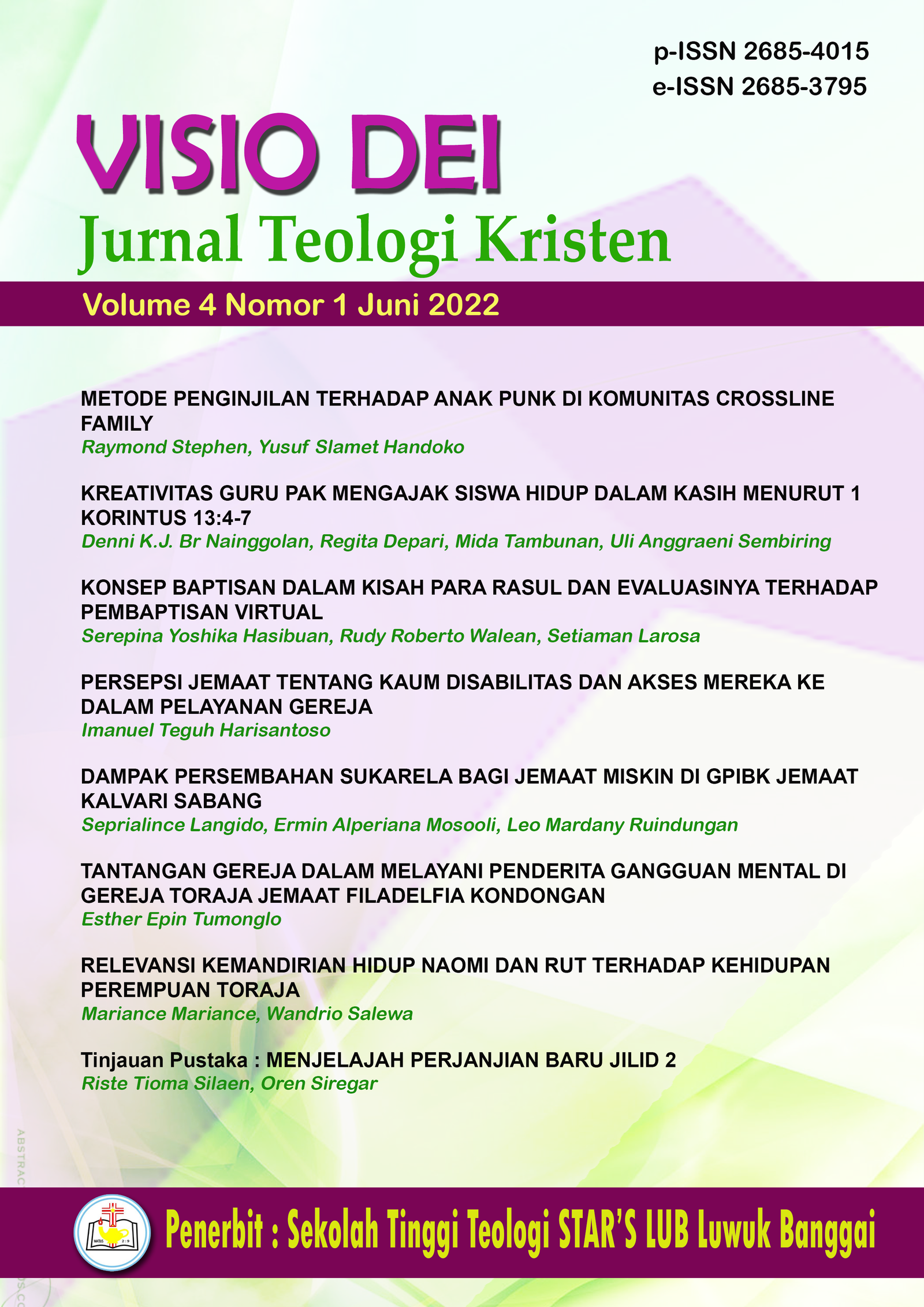CHURCH MEMBERS PERCEPTION OF PEOPLE WITH DISABILITIES AND THEIR ACCESS TO CHURCH SERVICES
Abstract
This study explores the congregation's understanding of disability and their access to church services. The research subjects are taken from 53 congregations spread over 18 synods. The methodology used is descriptive qualitative with data collection techniques through open interviews, visiting participants directly, and communication technology media for participants who are not reached face to face. Six informants were involved in each congregation, consisting of one pastor and five church council members. The study suggests that churches view disability as stereotyping, stigmatizing, and harmful. The Church provides opportunities for disability involvement in ministry but in minimal opportunities. It provides normality criteria for people with disabilities to be able to serve. CHURCH MEMBERS PERCEPTION OF PEOPLE WITH DISABILITIES AND THEIR ACCESS TO CHURCH SERVICES.
Downloads
References
Anshari, M. (2020). Teori Disabilitas: Sebuah Review Literatur. Modernity: Jurnal Pendidikan Dan Islam Kontemporer, 1(1), 35–40.
CBM. (2017). Disability Inclusive Development Toolkit.
Creamer, D. B. (2009). Disability and Christian Theology Embodied Limits and Constructive Possibilities. Oxford University Press.
Dahlan, M., & Anggoro, S. A. (2021). Hak atas Pekerjaan bagi Penyandang Disabilitas di Sektor Publik: Antara Model Disabilitas Sosial dan Medis. Undang: Jurnal Hukum, 4(1), 1–48. https://doi.org/10.22437/ujh.4.1.1-48
Darling, R. B. (2013). Disabiliti and Identityt: negotiation self in a changing society. Lynne Rienner Publisher.
Demartoto, A. (2007). Menyibak Sensitivitas Gender dalam Keluarga Difabel. LPP-UNS Press.
Devi, Ivan, & Rumbi, F. P. (2021). Peran Gereja dalam Memberdayakan Penyandang Disabilitas di Gereja Toraja Jemaat Kaero. Kinaa: Jurnal Kepemimpinan Kristen Dan Pemberdayaan Jemaat, 2(1), 57–67. https://doi.org/10.34307/kinaa.v2i1.26
Ellis, K. (2015). Disability and Popular Culture: Focusing Passion, Creating Community and Expressing Defiance. Ashgate Publishingg Company.
Goffman, E. (1963). Stigma: notes on the management of spoiled identity. Englewood Cliffs.
Innawati. (2021). Pemuridan pemberdayaan Bagi Jemaat Disabilitas Dalam Pelayanan Mimbar Di Gereja Inklusif (Sebuah Penelitian Eksperimen di Gereja Jemaat Kristen Indonesia Bukit Sion Mangliawan). Jurnal Amanat Agung, 17(1), 88–119. https://doi.org/10.47754/jaa.v17i1.457
Karnawati. (2020). Pemahaman dan Kontribusi Gereja Terhadap Hak Penyandang Disabilitas. Indonesian Conference on Religion and Peace - Persekutuan Gereja-Gereja Di Indonesia (PGI), 1, 122–131.
Karuniasih, N. N. M. P., Nugroho, W. B., & Kamajaya, G. (2017). Tinjauan Fenomenologi Atas Stigmatisasi Sosial Penyandang Disabilitas Tunarungu. Jurnal Ilmiah Sosiologi, 1(1).
Lawson, W. (2008). Concepts Of Normality. Jessica Kingsley Publishers.
Marx, T. C. (2002). Disability In Jewish Law. Routldge.
McLean, S. A. M., & Williamson, L. (2007). Impairment and Disability: law and ethics at the beginning and end of life. Routledge-Cavendish.
Miraji, T. (2021). Pandangan Teologis Terhadap Kaum Disabilitas dan Implementasinya Bagi Gereja Masa Kini. SAGACITY Journal of Theology and Christian Education, 1(2), 65–86.
Oliver, M. (1996). Understanding Disability: From Theory to Pactice. Macmillan Education.
Olyan, S. M. (2008). Disability in the Hebrew Bible. Cambridge University Press.
Probosiwi, R. (2013). Keterlibatan Penyandang Disabilitas Dalam Penanggulangan Bencana (Person With Disabilities Involtment On Disaster Prevention). Jurnal Dialog Penanggulangan Bencana, 4(2), 77–86.
Putra, R. S., Marpaung, Y. N. M., Pradhana, Y., & Rimbananto, M. R. (2021). Pesan Kesetaraan Penyandang Disabilitas Melalui Interaksi Simbolik Media Sosial. Interaksi: Jurnal Ilmu Komunikasi, 10(1), 1–11. https://doi.org/10.14710/interaksi.10.1.1-11
Raphael, R. (2008). Biblica Corpora: Representations of Disability in Hebrew Biblical Literature. T & T Clark International.
Rapley, M. (2004). The Social Construction of Intellectual Disability. Cambridge University Press.
Salsabila, N., Krisnani, H., & Apsari, N. C. (2018). Rehabilitasi Sosial Bagi Remaja Dengan Disabilitas Sensorik. Focus: Jurnal Pekerjaan Sosial, 1(1), 190–203. https://doi.org/10.24198/focus.v1i3.20496
Santoso, M. B., & Apsari, N. C. (2017). Pergeseran Paradigma dalam Disabilitas. Intermestic: Journal of International Studiese, 1(2), 166–176. https://doi.org/10.24198/intermestic.v1n2.6
Sinulingga, I. N. (2016). Disabilitas sebagaii Objek Ilmu Pengetahuan: Retardasi Mental dalam Peziarahan Normalisme. In R. Arulangi, H. A. Harmakaputra, N. Sasongko, & A. S. Wilar (Eds.), Dari Disabilitas ke Penebusan (pp. 1–23). BPK Gunung Mulia.
Snyder, S. L., & Mitchell, D. T. (2006). Cultural Locations of Disability. The University of Chicago Press.
Soles, J. C. (2018). Disability and the Bible. The Christian Citizen. https://medium.com/christian-citizen/disability-and-the-bible-343f4f788744
Subasno, Y., Kaka, I. A., & Yulius, M. I. (2020). Pengetahuan dan Sikap Umat Katolik terhadap Pemenuhan Hak Penyandang Disabilitas di Lingkungan St. Filemon Paroki Blimbing Keuskupan Malang. SAPA: Jurnal Kateketik Dan Pastoral, 5(2), 55–76. https://doi.org/10.53544/sapa.v5i2.134
Sugiyono. (2018). Metode Penelitian Kuantitatif, Kualitatif, dan R&D. Alfabeta.
Sweety. (2021). Sekolah Minggu Ramah Anak: Menuju Arah Baru sekolah Minggu yang Peduli Anak dengan Disabilitas. In H. A. Harmakaputra, K. Diredja, & M. Alexander (Eds.), Meretas Polarisasi Pendidikan Kristiani (pp. 73–99). BPK Gunung Mulia.
Teddywono, I. (2020). Pemuridan Bagi Jemaat Penyandang Disabilitas. Sanctum Domine Jurnal Teologi, 10(1), 17–34. https://doi.org/10.46495/sdjt.v10i1.82
Utami, T. K. (2019). Penyandang disabilitas Di Kabupaten Cianjur Dikaji Dalam Perspektif Hak Asasi Manusia. Jurnal Ilmiah Living Law, 11(2), 131–139. https://doi.org/10.30997/jill.v11i2.2102
WHO. (2015). WHO Global Disability Action Plan 2014-2021 Better Health for All People with Disability.
Widinarsih, D. (2019). Penyandang Disabilitas di Indonesia: Perkembangan Istilah dan Definisi. Jurnal Ilmu Kesejahteraan Sosial, 2(20), 127–142. https://doi.org/10.7454/jurnalkessos.v20i2.239
Widyastutik, C. (2021). Makna Stigma Sosial Bagi Disabilitas Di Desa Semen Kecamatan Paron Kabupaten Ngawi. Jurnal Paradigma, 10(1).
World Bank and World Health Organisation. (2011). World Disability Report.
Zendrato, R. A. (2018). Gereja dan Penyandang Disabilitas. Sekolah Tinggi Amanat Agung.
Copyright (c) 2022 Imanuel Teguh Harisantoso

This work is licensed under a Creative Commons Attribution-ShareAlike 4.0 International License.
Visio Dei: Jurnal Teologi Kristen publishes articles under the Creative Commons Attribution-ShareAlike 4.0 (CC BY-SA 4.0). Users are free to copy, modify, or redistribute articles for any lawful purpose in any media, provided they give appropriate credit to the original author and Visio Dei: Jurnal Teologi Kristen as the publisher, links to the license, indicate if changes have been made, and redistribute any derivative works under the same license.
Article copyright is held by the respective author (s), without limitation. A non-exclusive license is granted to Visio Dei: Jurnal Teologi Kristen to publish articles and identify itself as the original publisher, including commercial rights to sell them to libraries and individuals.
By publishing articles in Visio Dei: Jurnal Teologi Kristen, authors grant rights to third parties to use their articles to the extent granted by the Creative Commons Attribution-ShareAlike 4.0 International license.














